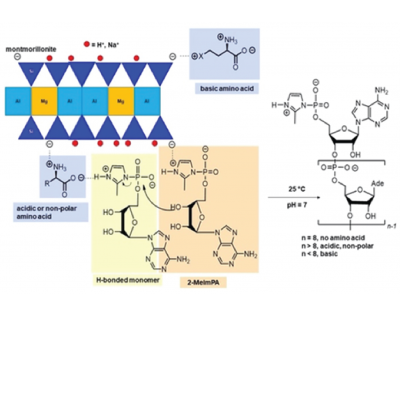
The authors examined the effects of different amino acids on activated nucleotide, 2-MelmpA, montmorillonite-promoted polymerization at neutral pH. Polymerization in the presence of non-polar and acidic amino acids resulted in longer oligomer formation of up to 10 mers compared to the reference system, which does not contain amino acids, indicating facilitation of polymerization of 2-MelmPA. In contrast, basic amino acids and polar amino acids resulted in significant suppression in the polymerization and yielding oligomers with short length. Interestingly, acidic and nonpolar amino acids with simple side chains are among the most prebiotically plausible alpha amino acids, which has shown promoting effects on the non-enzymatic polymerization reactions of 2-MeImPA. Several dicarboxylic acids and various organic molecules containing diamine functionalities have been studied to understand the influence of amino acids on the polymerization reaction, showing similar polymerization results to that of the reference system, indicating that carboxylate and ammonium function groups are important in the polymerization process. Furthermore, β-alanine and 6-amino hexanoic acid had no impact on polymerization, therefore, it appears both amine and carboxylate groups need to be at the Cα position.
In addition, the effectiveness of acidic amino acids even at lower concentrations of Mg2+ ions or even in the absence of Mg2+, shows that they are not necessary for clay and amino acid promoted non-enzymatic RNA polymerization. This is significant because high Mg2+ concentrations are fatal to the self-assembly of protocell fatty acid membranes. The present paper shows that molecular mutualisms between mineral, membranes, proteins and RNA molecules was likely an important process in the early evolution of biopolymers and self-assembly processes.
Namani, T., Snyder, S., Eagan, J.M., Bevilacqua, P.C., Wesdemiotis, C. and Sahai, N. (2021), Amino Acid Specific Nonenzymatic Montmorillonite‐Promoted RNA Polymerization. ChemSystemsChem. https://doi.org/10.1002/syst.202000060
